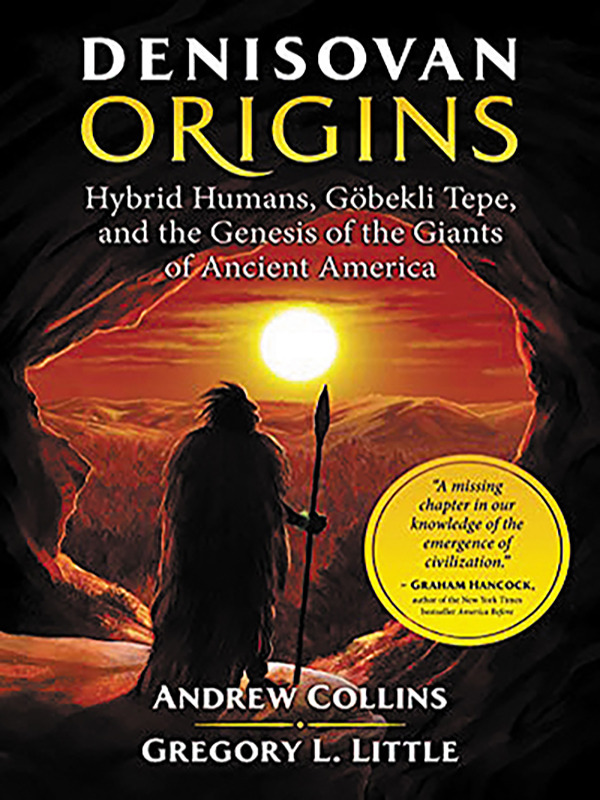Denisovan Origins: Hybrid Humans, Göbekli Tepe and the Genesis of the Giants of Ancient America
$25.00
Andrew Collins and Gregory L. Little reveal the profound influence of the Denisovans—a genetically Homo sapiens /Neanderthal hybrid, whose bones were discovered in Siberia—and their hybrid descendants upon the flowering of human civilization around the world.
The authors trace the migrations of the sophisticated Denisovans and their interbreeding with other hominid populations over 40,000 years ago.
Ice-age cave artists, the builders at Göbekli Tepe and the mound-builders of North America all share a common ancestry in the Solutreans, who, the authors say, were themselves hybrids of immense sophistication. They dominated southwest Europe before reaching North America 20,000 years ago.
- Description
- Additional information
Description
Andrew Collins and Gregory L. Little reveal the profound influence of the Denisovans—a genetically Homo sapiens /Neanderthal hybrid, whose bones were discovered in Siberia—and their hybrid descendants upon the flowering of human civilization around the world.
The authors trace the migrations of the sophisticated Denisovans and their interbreeding with other hominid populations over 40,000 years ago.
Ice-age cave artists, the builders at Göbekli Tepe and the mound-builders of North America all share a common ancestry in the Solutreans, who, the authors say, were themselves hybrids of immense sophistication. They dominated southwest Europe before reaching North America 20,000 years ago.
Yet, even before the Solutreans, the American continent was home to a powerful population of unusually tall men and women remembered in Native American legend as the Thunder People. New research shows they were hybrid descendants of an extinct human group known as the Denisovans, whose existence has now been confirmed from fossil remains and the latest DNA evidence.
Tracing the migrations of the Denisovans and their interbreeding with Neanderthals and early human populations in Asia, Europe, Australia and the Americas, Collins and Little explore how the new mental capabilities of the Denisovan-Neanderthal and Denisovan-Homo sapiens hybrids greatly accelerated the flowering of human civilization over 40,000 years ago. They show how the Denisovans displayed technological advances, including precision stone tools and intricate jewelry, tailored clothing, celestially aligned architecture and horse domestication.
Examining evidence from ancient America, the authors reveal how Denisovan hybrids became the elite of the Adena mound-building culture, explaining the giant skeletons found in Native American burial mounds. The authors also explore how the descendants of the Denisovans were the creators of the cosmological death journey and viewed the Milky Way as the Path of Souls.
Revealing the impact of the Denisovans upon every part of the world, the authors show that, without early man’s hybridization with Denisovans, Neanderthals and other yet-to-be-discovered hominid populations, the modern world as we know it would not exist.
Softcover, 438 pages, #877
About the Authors
Andrew Collins is a science and history writer, who has been investigating the origins of human civilization for over three decades. He is a noted explorer and the co-discoverer of a massive cave complex beneath the Giza plateau, now known as “Collins’ Caves.” He is the author of several bestselling books, including From the Ashes of Angels and Gobekli Tepe: Genesis of the Gods. He lives in southeast England.
Gregory L. Little, Ed.D., is the author of over 30 books, including Edgar Cayce’s Atlantis and The Illustrated Encyclopedia of Native American Indian Mounds and Earthworks. His research has been featured on the National Geographic Channel, MSNBC, Discovery, and the History Channel. He lives in Memphis, Tennessee.
Reviews
“Collins and Little are the perfect team to address one of humanity’s greatest enigmas. . . . From giant skeletons to the mysterious mound builders of ancient America, this team assembles the lost pieces of the human time line.” Sidney D. Kirkpatrick, award-winning New York Times bestselling author and documentary film director
“Andrew Collins and Greg Little are two of the most respected writers in the ancient mysteries subject. They team up to provide a comprehensive account of the enigmatic Denisovans and their impact on the emergence of modern human society. If they are correct in their findings, as I very much suspect they are, then they have discovered a missing chapter in our knowledge of the emergence of civilization, both in the ancient world and—as I put forward in my own book America Before—in the Americas.” Graham Hancock, author of the New York Times bestseller America Before
“Tracing the migrations of the Denisovans and their interbreeding with Neanderthals and early human populations in Asia, Europe, Australia, and the Americas, the authors explore how the new mental capabilities of the Denisovan-Neanderthal and Denisovan-human hybrids greatly accelerated the flowering of human civilisation over 40,000 years ago. They show how the Denisovans displayed sophisticated advances, including precision machined stone tools and jewellery, tailored clothing, celestially-aligned architecture, and horse domestication. Without early human’s hybridisation with Denisovans, Neanderthals, and other yet-to-bediscovered hominid populations, the modern world as we know it would not exist.” Nexus Magazine
Additional information
| Weight | 1.4 lbs |
|---|---|
| Dimensions | 6.6 × 0.9 × 9.5 in |








